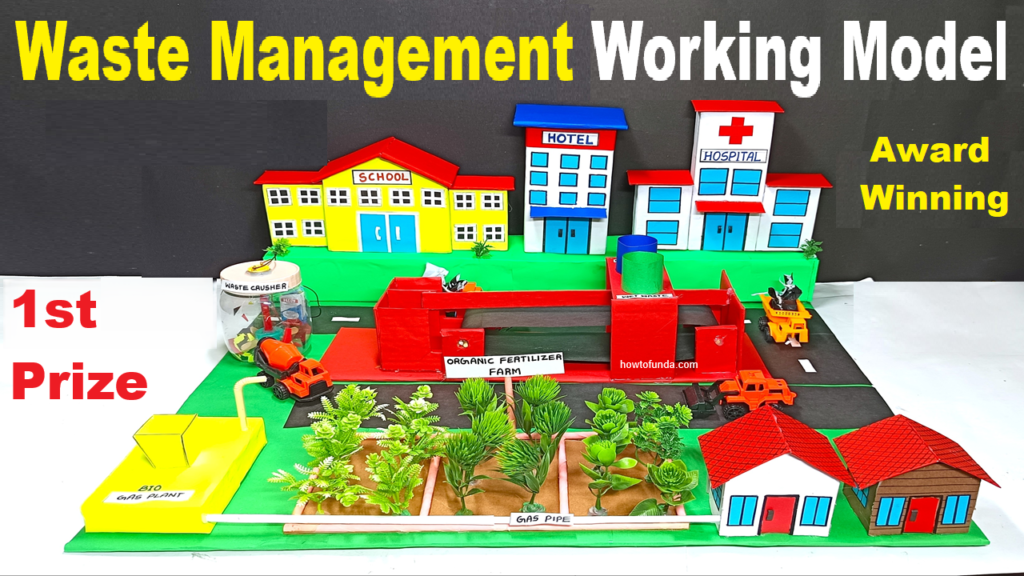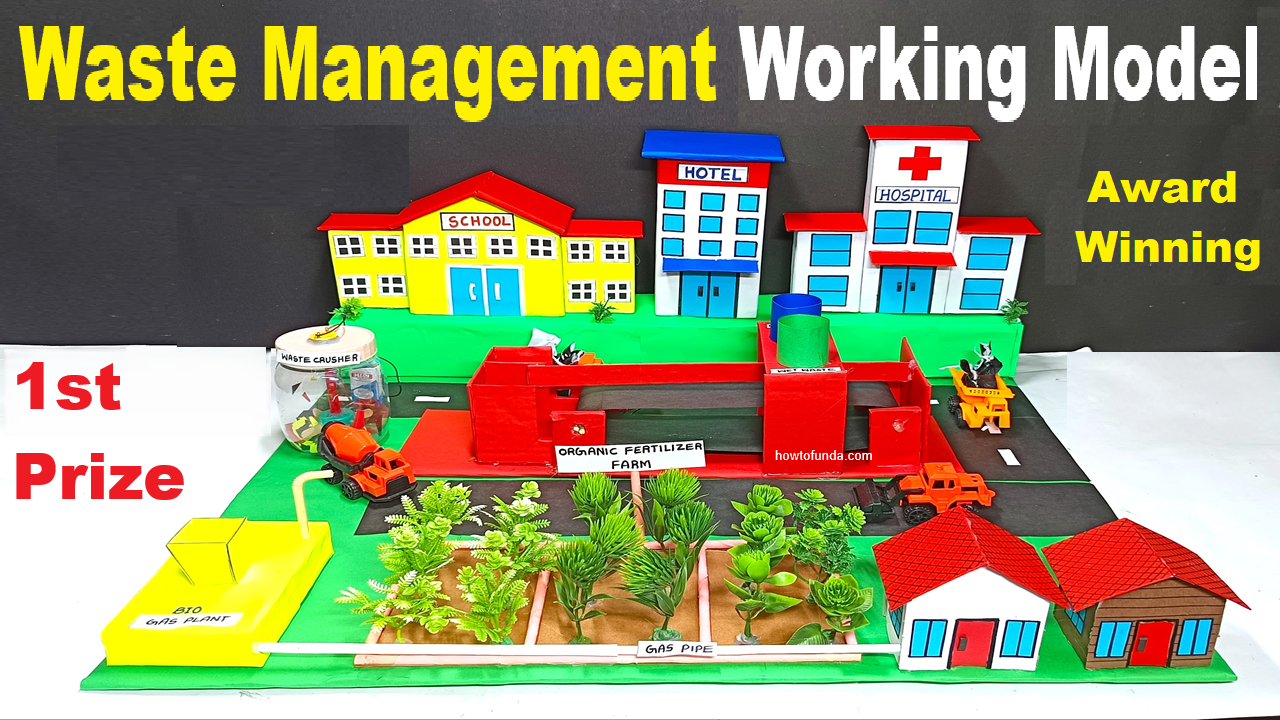Creating a Waste Management and Recycling Techniques Working Model with an Eco-Friendly Approach that includes waste segregation, tar road construction using dry waste, organic farming using compost, and biogas (gobar gas) production using wet waste will be an excellent and educational project!

Model Concept:
This model will showcase:
- Waste Segregation: Proper separation of dry and wet waste.
- Tar Road Construction Using Dry Waste: Using plastic waste for making durable roads.
- Organic Farming Using Compost from Wet Waste: Converting food waste into organic fertilizer.
- Biogas (Gobar Gas) Production Using Wet Waste: Using cow dung and food waste to generate methane gas.
Materials Required:
For Waste Segregation:
- Three Miniature Dustbins (Green, Blue, and Red)
- Cardboard and Color Paper
- Toy or Paper Cutout of a Waste Collection Truck
- Labels for Different Types of Waste
For Tar Road Construction Using Dry Waste:
- Plastic Bags, Wrappers, and Bottles (Shredded)
- Bitumen (or Black Paint + Sand Mixture)
- Cardboard or Wooden Base
- Glue or Hot Glue Gun
For Organic Farming Using Compost from Wet Waste:
- Small Plastic Container (Compost Bin with Holes)
- Soil and Small Plants
- Vegetable Peels, Fruit Peels, Food Waste
For Biogas Plant (Gobar Gas) Using Wet Waste:
- Plastic Bottle or Small Container (Biodigester)
- Cow Dung (or Paper Pulp as a Substitute for Demo)
- Plastic Pipe (for Gas Flow)
- Small Balloon or LED Light (for Gas Collection Demonstration)
- Water for Anaerobic Decomposition
Steps to Build the Model:
1. Waste Segregation Concept
Set up three dustbins:
- Green Bin → Wet Waste (Vegetable Peels, Food Waste, Cow Dung)
- Blue Bin → Dry Waste (Plastic, Paper, Metal, Glass)
- Red Bin → Hazardous Waste (Batteries, E-Waste, Chemicals)
Create a Mini Garbage Truck: Show the collection and disposal process.
Demonstrate Proper Waste Sorting: Attach labels to show what items go in which bin.
Working Principle:
Waste segregation helps in better recycling and prevents environmental pollution.
2. Tar Road Using Dry Waste (Plastic Waste Recycling)
Prepare the Base: Use cardboard or wood for road structure.
Shred Plastic Waste: Cut plastic into small pieces.
Mix with Bitumen: If real bitumen is unavailable, use a black paint + sand mixture.
Layer the Road: Apply the plastic and bitumen mixture to the road model.
Final Touch: Add road signs and toy vehicles.
Working Principle:
Plastic waste is melted and mixed with bitumen, making roads stronger and reducing plastic pollution.
3. Organic Farming Using Compost from Wet Waste
Set Up a Compost Bin: Use a plastic container with air holes.
Add Wet Waste: Vegetable peels, fruit peels, and biodegradable materials.
Decomposition Process: Allow the waste to break down into compost.
Create a Small Farming Setup: Place soil in a section of the model and plant saplings.
Use the Compost: Mix it into the soil to show how it improves plant growth.
Working Principle:
Organic waste decomposes into compost, enriching the soil and reducing chemical fertilizer use.
4. Biogas Plant (Gobar Gas) Using Wet Waste
Build the Digester: Use a plastic bottle as the main chamber.
Fill with Cow Dung and Wet Waste: Mix with water for anaerobic fermentation.
Attach a Gas Collection Pipe: A small pipe leading to a balloon or an LED light.
Demonstration: As the waste ferments, the balloon inflates or the LED light turns on.
Working Principle:
Cow dung and food waste decompose in an anaerobic environment, producing methane (biogas), which can be used for cooking or electricity.

